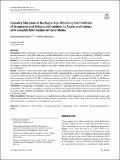Sexuality education in the digital age : modelling the predictors of acceptance and behavioural intention to access and interact with sexuality information on social media
Abstract
Introduction Diverse literature on sexual health promotion using social media suggests that increasing information reach and interaction are crucial. This study integrated the unified theory of acceptance and use of technology (UTAUT) to model the predictors of young adults’ behavioural intention to use and interact with sexuality education on social media. Methods A total of 936 young adults in Kenya, Nigeria, and South Africa who had access to the internet and Facebook were recruited via Facebook’s advertising platform from 22 May 2020 to 8 June 2020. A structural equation model was fitted on the sample to identify the individual attributes associated with the intention to use and interact with sexuality information on social media. Results About 84% of the young adults in the sample consider social media an appropriate medium for sexual health communication, with Facebook being the most preferred (40%) digital platform for sexual health promotion. Results from the structural equation model showed that performance expectancy (β = 0.18, P < 0.001), social influence (β = 0.09, P = 0.047), effort expectancy (β = 0.25, P < 0.001), facilitating condition (β = 0.33, P < 0.001), and attitude (β = 0.10, P = 0.039) were significantly associated with the intention to access sexuality education on social media. These factors (except attitude) were also significantly associated with the intention to interact with sexual health information on social media. Conclusions Young people with internet access are amenable to receiving and interacting with sexuality information on social media. The use of social media for sexuality education is associated with whether such use is free of effort, endorsed by society, align with their engagements with other messages, and helps them achieve improvement in their sexual and reproductive health. Policy Implications Strategies to increase access and interaction with sexuality information on social media help young people make an informed decision about their sexuality. Such use should also be free of effort, align with the way they interact with other information on social media, and supported by the society.
Citation
Olamijuwon , E & Odimegwu , C 2021 , ' Sexuality education in the digital age : modelling the predictors of acceptance and behavioural intention to access and interact with sexuality information on social media ' , Sexuality Research and Social Policy , vol. First Online . https://doi.org/10.1007/s13178-021-00619-1
Publication
Sexuality Research and Social Policy
Status
Peer reviewed
ISSN
1868-9884Type
Journal article
Description
The authors gratefully acknowledge the Southern Africa Systems Analysis Centre (SASAC) and the University of the Witwatersrand for providing partial funding to support this study.Collections
Items in the St Andrews Research Repository are protected by copyright, with all rights reserved, unless otherwise indicated.

